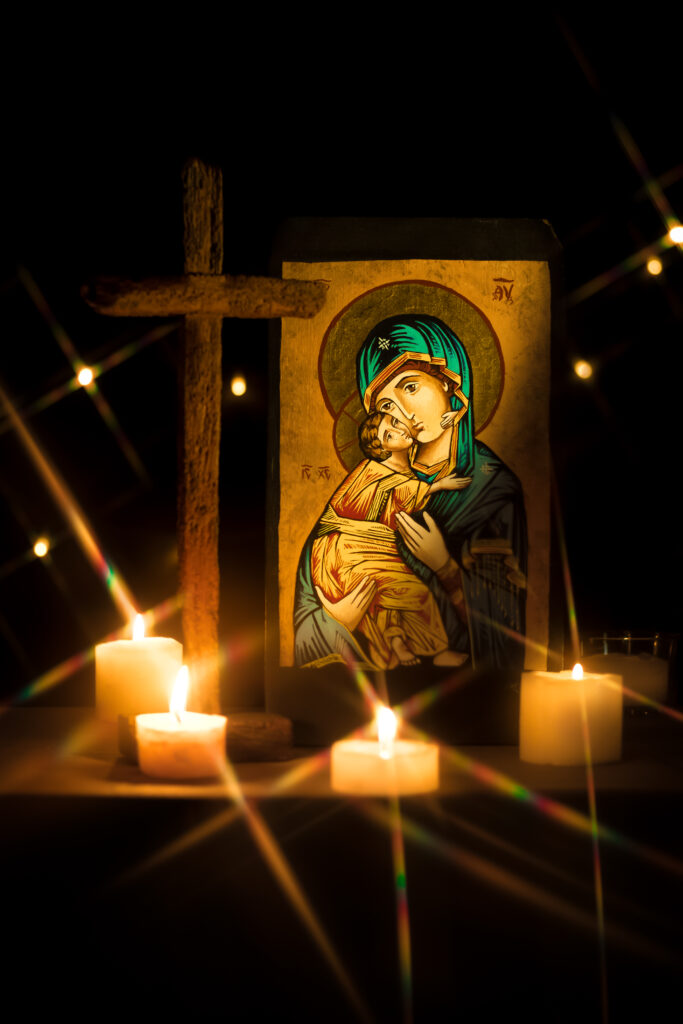
At first, I thought I’d freeze to death. A college class I was taking included a field trip to an Orthodox Church service in upstate New York in January. The winter air felt so frigid I thought it might crack. Ice crunched under our feet.
Then I worried I’d be bored to death. “Stand through a three-hour church service?!” I complained to myself, “I can hardly sit through a 45-minute lecture!”
RELATED: How the Byzantine Liturgy Reinvigorated My Faith
Yet, entering the church, I entered another world. It was a world not only of candles and incense, but also of images. Heaven itself seemed to have gathered under the domed ceiling. Icons, some peering behind large, glass frames and others painted on small plain wooden blocks, clothed the entire interior. Companies of saints, martyrs, and prophets looked out onto the congregation with large, luminous eyes and gilded half-moon halos. Many depicted the Virgin Mary, her left hand holding her son close and her right hand offering her blessing. I am a Protestant, but had, even then, attended services of many Roman Catholic churches. So while I had seen icons in churches before, I still had to catch my breath. The vitality of the figures and the vigor of their strength burst through their frames, the paint, and dim interior of the church. The icons sucked the breath out of me.
As parishioners both entered and left the church, mothers kissed and bowed to the icons and lifted their children to do the same. Others touched the images and crossed themselves. No one said a word; no one needed to.
The beauty of the icons and their rituals both charmed and alarmed me. The rituals involving icons seemed slightly idolatrous and at the same time seemed like…hushed holiness. While the icons said nothing, they seemed to speak to me of God in a deeply intimate way. I had to know more about them.
RELATED: Using Art as a Path to the Holy Spirit
A famous legend retold by author Ida Sinkević in “Windows to Heaven” says that Christ made the first icon. An Eastern king, falling deathly ill, wrote a letter asking Christ to come and heal him. Instead, Christ sent an image of his face on a cloth. The image of Christ cured the king.
The practice of painting icons spread through the Christian world, especially after Emperor Constantine ordered tolerance for Christians throughout the Roman Empire in 313 A.D. Yet, by the eighth century, the Second Council of Nicaea in 787 A.D. addressed the question: “Were icons idolatrous?” The Council said, “No.”
To forcefully affirm icons, the Council held that there is a difference between worshiping icons and honoring them. Once I learned of this crucial distinction, it was easier to understand both their use and their value.
Icons are not just historic relics. They can play a vital role in devotions. Pope Benedict XVI wrote that beautiful images were essential in our worship practice.

RELATED: Praying With Your Eyes: How to Get Started With Visio Divina
You can travel far to find icons, but they often find you. At the Black Madonna shrine at Częstochowa, Poland, hundreds of pilgrims and the Polish faithful crowded into the shrine to honor the Madonna. Even though I went there as a visitor, I returned as a pilgrim. The shrine is enormous and I was way in the back. At first, I couldn’t see her at all; then a 6-foot-6 man paved the way for us through the crowd to get closer to the icon. I followed behind him. When I saw her sad, dark eyes, I felt haunted and humbled somehow, like we were all praying with her, and she was all the while praying for us.
As I’ve prayed with, read about, and just gazed at icons over the decades, I changed from seeing icons as “art” to seeing them as a way to listen to God. They are neither artifacts in a museum nor ornaments simply to adorn a wall. They beautify churches and home worship spaces because they point to Christ, the true beauty. They are lovely because they remind us that the holy person depicted lived a lovely life–and that we can do the same.
The first step is simply to spend time with them. The more you connect with the icon, the deeper you connect with the person in the icon. Icons are often quiet companions in churches. You could also find photos of them online or in a library book. Linger over the images, the color, faces, and hands. Savor them. Share their quiet. The more you listen, the more you will hear.